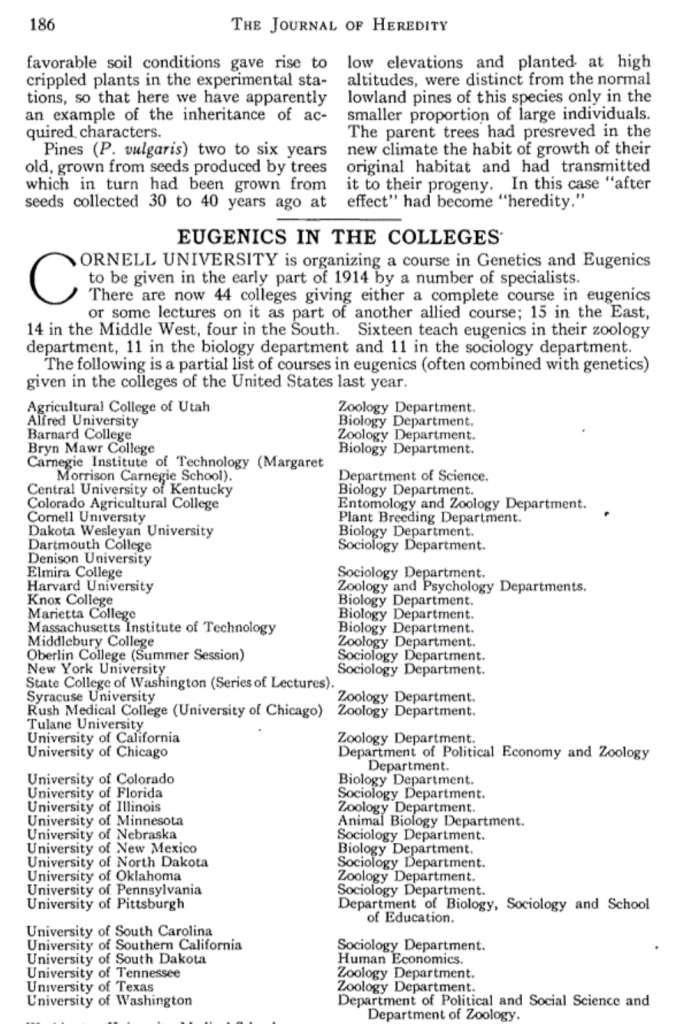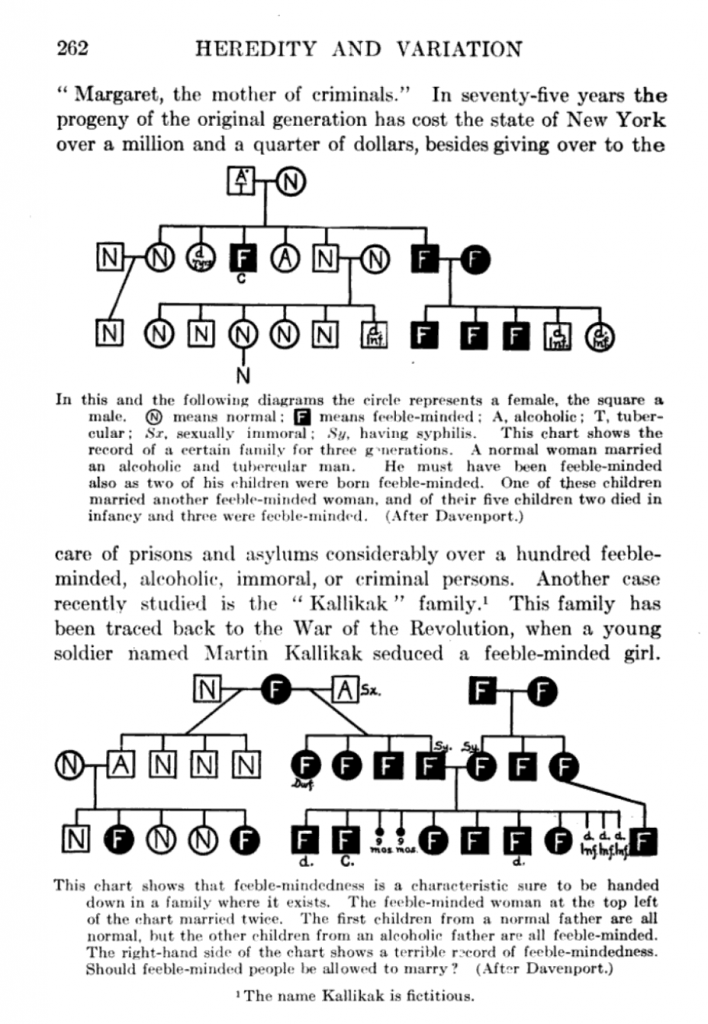
Archive Exhibit 4: Eugenics in Biology Classrooms
Most biologists believed that eugenics was an important means through which they could make a difference. Many of the leading spokesmen of the movement were trained biologists. Charles Davenport possessed a PhD in zoology from Harvard and had done influential work in ecology prior to taking up eugenics work. Harvard zoologist G.H. Parker wrote about eugenics (in the pages of Science) as biologists’ best form of public service. ‘It is coming to be a commonplace statement,’ Parker wrote, ‘that we have paid more attention to the production of high-grade breeds of sheep, cattle, swine, and so forth, than we have to that of effective human beings, and this statement gains popular strength as we awaken one by one to the fact that man is, after all, a member of the animal kingdom and subject to its laws.’ Though not, he explained, an expert on the topic, he thought it important for zoologists to speak on the matter.

The commitment to eugenics had a huge impact on biology curricula at universities across the country. In 1914 the Journal of Heredity noted with approval that forty-four colleges offered courses in eugenics in a range of different departments (the University of Washington’s courses on eugenics were taught by the political science and zoology faculty). By 1928, 376 college courses on eugenics existed across the country. Note that by 1914 these courses were “often combined with genetics.”
The pervasiveness of eugenics as part of the biology curricula is perhaps best illustrated by the fact that Dr. Thomas Wyatt Turner, the first Black American to receive a Ph.D in biology and a co-founder of the NAACP, taught a course on eugenics at Howard University. Indeed, Turner used eugenics against the doctrines of white supremacy by arguing that the “best blacks” are every bit as “fit” as the “best whites.”

In an era of increasing secondary school enrollment, George William Hunter’s Civic Biology was one of the most popular high school biology textbooks. Here are excerpts from the passages on eugenics:
Eugenics. – When people marry there are certain things that the individual as well as the race should demand. The most important of these is freedom from germ diseases which might be handed down to the offspring. Tuberculosis, syphilis, that dread disease which cripples and kills hundreds of thousands of innocent children, epilepsy, and feeble-mindedness are handicaps which it is not only unfair but criminal to hand down to posterity. The science of being well born is called eugenics.
Parasitism and its Cost to Society. – Hundreds of families such as those described above exist today, spreading disease, immorality, and crime to all parts of this country. The cost to society of such families is very severe. Just as certain animals or plants become parasitic on other plants or animals, these families have become parasitic on society. They not only do harm to others by corrupting, stealing, or spreading disease, but they are actually protected and cared for by the state out of public money. Largely for them the poorhouse and the asylum exist. They take from society, but they give nothing in return. They are true parasites.
The Remedy. – If such people were lower animals, we would probably kill them off to prevent them from spreading. Humanity will not allow this, but we do have the remedy of separating the sexes in asylums or other places and in various ways preventing intermarriage and the possibilities of perpetuating such a low and degenerate race. Remedies of this sort have been tried successfully in Europe and are now meeting with some success in this country.
William Jennings Bryan, three-time democratic presidential candidate and member of the prosecution in the famous Scopes ‘Monkey’ trial of 1925, cited Hunter’s textbook as an example of why evolution should be removed from U.S. high school and college classrooms (John T. Scopes had used Hunter’s textbook in class). Here, Hunter describes the progeny of Martin Kallikak and a ‘feebleminded girl.’ Biologists often cited the Kallikak family as an example of ‘dysgenic breeding.’ Slater wrote the name Kallikak in his notebook while taking notes from a textbook on genetics and eugenics by Walters.

Harvard geneticist William Castle published the first edition of his textbook in 1916. This would become the most widely used college textbook on genetics for decades. In the 1932 edition Castle criticized the use of biology to justify anti-race mixing laws, illustrating the presence of variation among thinkers who supported eugenics. Castle worried more about how to increase the “general average of bodily vigor or innate mental power” within the population as a whole, while frankly stating geneticists were far too ignorant of heredity to legislate with that goal in mind. Still, he urged, individuals to make marriage decisions that attended to whether they could contribute to the production of a “sound and healthy stock.” If the answer was no, he or she “should fulfill the racial obligation vicariously by helping to care for and to educate the children of his more fortunate fellows.” (p. 405).

Edwin Grant Conklin’s Heredity and Environment in the Development of Men (1915)
Princeton Professor of Biology Edwin Grant Conklin’s textbook Heredity and Environment in the Development of Men went through several editions. In the section on Immigration (in a chapter entitled ‘Control of Heredity: Eugenics’) Conklin wrote: ‘From the amalgamation of good races good results may be expected; but fusion with inferior races, while it may help to raise the lower race, is very apt to pull the higher race down. How insignificant are considerations of cheap labor and rapid development of natural resources when compared with these biological consequences!’ (p. 285)
This copy of Conklin’s book, from Puget Sound’s library collection, illustrates changes in readers’ willingness to take the fundamental assumptions of much of eugenic thinking for granted. The marginalia reads: ‘Not a high correlation.’ ‘?’ ‘! Wrong!’ ‘Sociologists disagree.’ ‘Congenital insanity can appear to be hereditary insanity.’ (congenital means present from birth, but not necessarily hereditary)